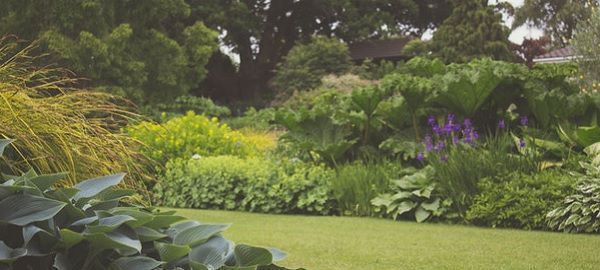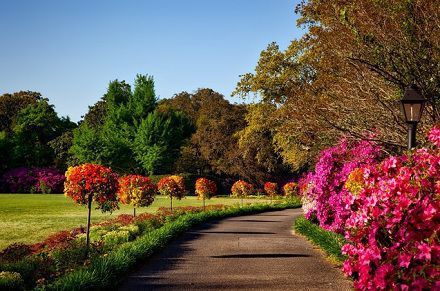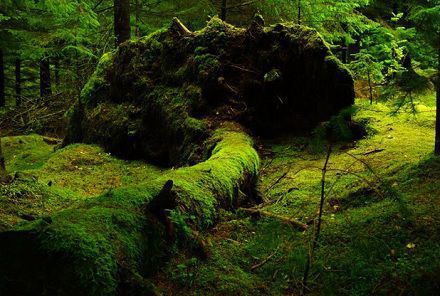Vascular plants or tracheophytes are known for their proper organization of the systems, and bearing flowers, green leaves, stems, roots, woods, and branches, on the contrary, Non-vascular plants or bryophytes do not perfectly fit with these features. Examples of Conifers, Ferns, flowering, and non-flowering plants are examples of vascular plants, while Mosses, Liverworts, and Hornworts are examples of non-vascular plants.
But most importantly the difference lies in the presence of the vascular system which is xylem and phloem. The xylem carries water and minerals to every part of the plant, while phloem carries food. So, the plants which have this well-organized system are categorized as vascular, whereas the plants where these systems are absent are known as non-vascular plants.
Plants are the multicellular, photosynthetic eukaryotes. Kingdom ‘Plantae‘ is also placed in under Five kingdom classification as one of the major kingdoms, containing huge varieties of plants. Further, this kingdom was classified into different categories, under non- vascular and vascular groups. The primitive form of plants is termed as non-vascular, while the advanced type is kept under vascular.
There are many different varieties of the plants found on earth and there are many more to discover. Till date there are around 320 thousand species of plants are known. Hereby, on the way of focusing on the difference between the two groups of plants i.e. vascular and non-vascular, we will also discuss on them briefly.
Content: Vascular Vs Non-Vascular Plants
Comparison Chart
| Basis for Comparison | Vascular Plants | Non-Vascular Plants |
|---|---|---|
| Meaning | Vascular plants are the green plants, which have specialized tissues for transporting food, water and minerals to all parts of the plant. These tissues (xylem and phloem) constitute the vascular system. These type of plants can grow much longer. | Non-Vascular plants are short height plants and lack transport system for minerals, food, water and gas. These plants do not produce wood, fruits or flowers. |
| Examples | Angiosperms, Gymnosperms, Ferns, Pines, Grasses, Sunflowers, Clubmosses, etc. | Liverworts, Hornworts and Mosses. |
| Grow on | Land, deserts, and other places. | Humid, moist, swampy and shady places are best suited for their survival. |
| Xylem and Phloem tissues (Vascular system) | Present. | Absent. |
| Lifecycle | Principal or dominating phase is sporophyte, which is diploid, and second is gametophyte. | Principal or dominating generation is gametophyte, and the second is sporophyte. |
| Roots | Vascular plants have a proper root system, which supports the plants to anchor the soil and gets nutrients from it. | Instead of roots, they have rhizoids (small hairs to support the plant firmly). |
| Leaves |
|
|
| Stem | The stem is multilayered in vascular plants and helps in protection, transportation of food, water, etc. | The true stem is not found in non-vascular plants. |
Definition of the Vascular Plants
Vascular plants, also known as Tracheophytes are the groups of higher plants, categorized in kingdom ‘Plantae’. These are the green plants, with the specialized plant tissue called as vascular tissues. This special issue is the main feature which varies them from the non-vascular plants. These two types of tissues are xylem and phloem. the vascular plants are responsible for the transportation of water, minerals, and other products to different parts of the plants.
The vascular plants can grow up to a height, they are found on land, deserts, aquatic environments, etc. They include Angiosperms, Gymnosperms, Pines, Clubmosses, Ferns, etc. The plants with the vascular system have well-defined root and shoot system, they also bear leaves, fruits, flowers, and wood.
The cells show proper differentiation, where xylem is made up of a structural protein called as lignin and carries minerals and water from roots to other parts. The role of phloem is to carry the products of photosynthesis that is glucose.
The vascular plants exhibit the alternation of generations to complete its life cycle. That means they have sexual or gametophytic phase and asexual or sporophytic phase. The sporophytes are the diploid organism and by the process of meiosis, they produce the haploid spores.
The haploids develop into the new young ones and undergo the gametophytic phase. These gametophytes produce gametes (male and female) which undergoes the sexual reproduction. The fusion of sperms and eggs (male and female) produces the zygote, which is the next diploid sporophyte generation.
Definition of the Non-Vascular Plants
Non-vascular plants are small and simple and include the liverworts or Haptophyta, hornworts or Anthocerotophyta and mosses or Bryophyta. They are also known as bryophytes. Non-vascular plants are said as the most primitive form of land vegetation categorized under kingdom ‘Plantae’.
These plants are not well developed and lack true leaves, stems, and roots, mainly they have a poor transport system. This transport system consists of the two tissues namely xylem and phloem are responsible for carrying minerals and water to different parts of the plants.
Though non-vascular plants have certain specialized tissues, which helps in transportation of water and other substances, as the specialized tissue do not have lignin and so does not said as the vascular tissue. These plants do not bear fruits, flowers or wood and are found in moist, shady areas.
The green parts of the plants are known as the thallus and rhizoids are the thin filaments, which anchor the plant to their place. Bryophytes or non-vascular plants show alternation of generations and cycle completes between sexual and asexual stages. The thallus is the gametophyte of the plant which develops male and female organs.
The gametophyte phase is the sexual phase and produces gametes. The photosynthesis takes place in the plant gametophyte and so non-vascular plants spend most of their time in the gametophyte phase and even the sporophytes are dependent on the gametophyte for nutrition.
The sporophyte is the asexual phase, where spores are produced. The sporophytes keep the spores and when get germinated they develop into a new plant. Mosses are most abundantly found among bryophytes and these plants look like dense mats of vegetation and grow on mountains, rocks, trees or glaciers.
Key Differences Between Vascular and Non-Vascular Plants
Upcoming points are essential in order to differentiate between vascular and non-vascular plants:
- Vascular plants are the green plants, which have true leaves, stems, roots, and bear fruits and flower, essentially they have specialized tissues (xylem and phloem) for transporting food, water, and minerals to all parts of the plant. These type of plants can grow much longer. Non-Vascular plants are short height plants, with poorly developed roots and stems, do not bear fruits and flowers, or woods and mainly lacks transport system carrying minerals, food, water, and gas.
- Angiosperms, Gymnosperms, Ferns, Pines, Grasses, Sunflowers, Clubmosses, etc. are examples of some of the vascular plants while Liverworts, hornworts, and mosses are examples of non-vascular plants.
- Vascular plants widely grow on widely in every part, while non-vascular plants are specified to marshy, swampy, moist and shady places.
- Xylem and Phloem tissues (Vascular system) is the critical point to discuss, as these tissues help in carrying food, water and minerals to all parts of the plants and these tissues are the specializations of vascular plants, while it is not found in non-vascular plants.
- The life cycle of both the plants are same, that means both types of plants go through the alternation of generations, but in vascular plants dominating phase is sporophyte, which is diploid and in non-vascular plants dominating generation is gametophyte, and second is sporophyte.
- Vascular plants have a proper root system, which supports the plants to anchor the soil and gets nutrients from its, whereas in non-vascular plants instead of roots, they have rhizoids (small hairs to support the plant firmly).
- Stems or shoot system is well developed in vascular plants and protect the plants, helps in exchange of gases, photosynthesis, etc., in non-vascular plants true stems are absent.
- Leaves of the vascular plants play a critical role in photosynthesis, which prevents the water loss and stomata works in gas exchange, whereas in non-vascular plants true leaves are absent, and there is no special function or specialized tissues against the water loss and for gas exchange.
Similarities
- Both the types of plants belonging to the same kingdom Plantae.
- As both are the types of plants so contains chlorophyll and chloroplast.
- They require water to grow.
- Both the types undergo photosynthesis and provide oxygen.
- Vascular and non-Vascular plants have waxy cuticles.
- Both the types show alternation of generation.
Conclusion
The first thing clicked on the mind or the picture which is created after listening to the word ‘Plant’ is of the green leaves, colorful flowers, fruits. Though from the above content it is much evidence that not all plants bear these items, some of them are categorized as plants but have different features from the typical green plants. We also considered a few similarities, due to which they both are kept in one group called as plants.




Leave a Reply